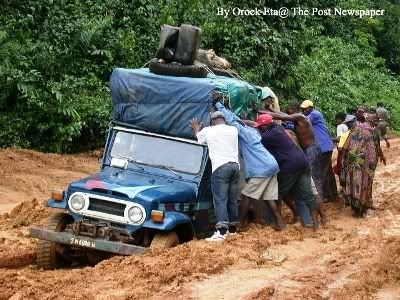Driving around Nairobi at the moment is a nightmare because of the state of the roads. Every rainy season wreaks havoc on smooth(ish) tarmac and when the rains have finished it is months before the fresh cracks and potholes are repaired. Narrow tarmac roads break away at the edges, becoming narrower and narrower until you have a strip only wide enough for one vehicle with steep drop offs on each side. It was precisely these conditions that caused my car to lose control on a wet evening in March, first tipping violently off the edge of one side of the road, then the next (bit too much over correcting), skidding into horizontal position then ploughing through a ditch, a hedge and almost into a field. My husband argued it was something to do with the sundowners that I had enjoyed at earlier the club but obviously I blame the road conditions entirely. Extracting the car out of its spot, wedged exactly halfway through the hedge proved a good hour and a half’s work involving tow ropes, kind passers by, security vehicles on standby, four wheel drive and a chainsaw.
One of the major problems here is the lack of proper roadside verges, pavements or drainage systems. The rain falls torrentially/tropically and eats into any available crack in the tarmac making ever increasing crevices. Rainy season is worst for pedestrians for whom no provision has been made by city planners and road construction outfits. During dry spells they must walk along dusty tracks by the side of the road, but in the wet the only option is to wade through what has become a veritable quagmire. It’s often necessary for walkers to remove shoes after a particularly muddy patch and wash them in a deep puddle in an effort to stay presentable. If a road happens to be running down hill, you get fast running streams on both sides. Walkers are thus forced to resort to road itself when possible, making it more dangerous for both themselves and passing drivers.
Bumping over ruts and holes in a car dislocates your spine. We all invest heavily in shock absorbers and suspension systems and renew them frequently. Near accidents occur daily when understandably cautious saloon car drivers veer unexpectedly into the centre of the road, straight into oncoming traffic, because they are overly preoccupied by smacking their bumper on a ridge or hole. When road works eventually begin the situation actually worsens. Men and ladies dressed in luminous bibs hold up green or red flags tied to long sticks and wave them and lower them without any attempt at communication with fellow road gang members. Drivers are left to make up their own mind over whether to stop or go, which invariably means that everyone just goes. It’s mayhem. The road workers then leave, having cut carefully drawn out symmetrical holes with sharp edges where once there were more organic, smaller shapes. The road remains in this state, as if carved out by the surgeon’s knife, for a good couple of weeks or so, leaving drivers to search desperately for occasional flat patches in amongst the rough. Finally, the road workers are back and the holes are duly filled in with spades and rollers and what we are left with, after year on year of the same old repair methods, is the ‘cobbled street’ effect, a wildly undulating road surface.
In Tanzania we bought our first car that came along at the same time as the first baby. It was a three door Suzuki Vitara. The backward facing baby seat could only fit in the front, as (ever mindful of safety) behind there was a severe lack of space and seatbelts. Each time I hit a pothole, the passenger door would fly open causing me to gasp and grab the baby’s leg, look through my fingers and hope there wasn’t a car coming the other way. The majority of roads were very good in Dar es Salaam; wide and smooth, all paid for by aid money and donors, but the dirt roads that connected the maze of expat houses were memorably bad. On some occasions our bonnets disappeared, spluttering under meters of water because the potholes were big enough to drive right inside then out again. A painful scraping sound as the underside of the car ran against rough ground was all too familiar.
Money has been thrown and thrown at roads in Kenya for years but that cash has somehow magically disappeared into the ether (or off shore bank accounts). I think that this country can honestly boast having the worst roads in the world. There are so few good roads here, that if you looked at each one on its own merits and then took a mean average, you wouldn’t get much better than a dusty donkey track. Duel carriageways have been planned, talked about and promised, sometimes graders appear and it looks like serious work is about to start but inevitably we still wind up with patchwork surfaces and makeshift solutions. No wonder so many get killed on the roads here each year and no wonder the politicians prefer helicopters.
*5,000 additional cars are currently registered on the roads in Kenya every month.
